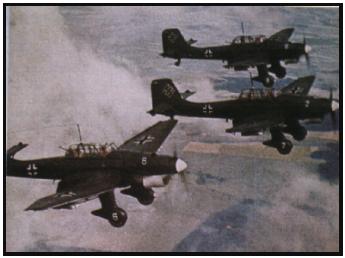
JU-87 G-1 Stuka
JU-87 Stuka
 |
JU-87 G-1 Stuka |
Technical Specification | |
| Two-seat anti-tank aircraft | |
| One Junkers Jumo 211J-1 in-line 12 cylinder liquid-cooled engine rated at 1059 kW (1,420 hp) at 2,600 rpm (take-off / emergency) and 887 kW (1,190 hp) at 2,400 rpm (max. continuous). | |
| Maximum speed 410 km/h (255 mph) at 3840 m (12,600 ft) : maximum cruising speed with bombload or gun pods 310 km/h (193 mph) at 4000 m (13,124 ft) : normal cruising speed 190 km/h (118 mph). | |
| Service ceiling 7,290 m (23,915 ft) : ceiling with max load 4,730 m (15,520 ft) : maximum range 1,535 km (954 miles) : normal radius of action 448 km (280 miles). | |
| Empty equipped 3900 kg (8,598 lb) : max take-off 6600 kg (14,551 lb). | |
| Span 15 m (49 ft 2.5 in) : length 11.5 m (37 ft 9 in) : height 3.88 m (12 ft 9 in) : wing area 33.69 m2 (343.47 sq ft) | |
| Two BK 37 37-mm cannon in underwing pods : one 7.92 mm MG 81 machine gun flexibly mounted in the rear cockpit : up to 1,800 kg (3,968 lb) of bombs or gun pods for up to 6 machine guns when the BK 37's were not being carried. | |

| Above : Nine Stuka Gruppen (wings) comprising some 336 aircraft were deployed against Poland.Thirty-one aircraft were lost in the campaign reflecting the lack of effective fighter opposition.Stukas normally flew in Kette , the three-aircraft formation seen here. |
|
Junkers JU-87 Stuka entered the world's vocabulary in May 1940.The mere appearance of its angular silhouette in the summer sky triggering 'Stuka fright' among the columns of soldiers and refugees fleeing across France.Ordered to attack road junctions , and especially bridges to hinder the movement of Allied ground forces , the Stuka often found their targets packed with escaping civilians.With sirens ('Jericho Trumpets') fitted to terrorize their victims , the bombers attacked with surgical precision-and then returned to strafe the survivors with their machine guns.The Stukas were like flying artillery , but with far greater range and flexibility.They struck at Allied divisions behind the front catching French heavy tanks still on their railway cars.In World War I it had proved impossible to break through the Western Front until 1918 , largely because the defenders could always bring up reinforcements to seal a gap faster then the batteries could advance over the shell-torn ground.The Stuka reversed the process : now the German army could on the move but the Allies could never react fast enough , their divisions slowed to a crawl by repeated air attacks behind the lines.However the Ju 87 did rely on German air superiority.Even over France , there were a number of disasters.One staffel (flight) was wiped out by five French fighters on 12 May.With a 100 mph speed advantage and armed with 20-mm cannon , the French fighters made short work of the lumbering and unmanoeuvrable Stukas.The Ju 87's defensive armament consisted of two fixed forward-firing 7.9-mm machine guns and one or two more operated by the observer on a flexible mounting in the cockpit rear.It was not enough to beat off a determined fighter pilot. |

| Above : Although the battles of 1940 showed that Stukas were vulnerable to modern fighters they were still effective in other theatres.JU 87B-2s like these wrought havoc on British ships in the Mediterranean in 1941. |
| click here for info on Stuka variants |
|
Dangerous Skies By then the Soviets had radar coverage of the battlefront and thousands of modern fighters with which to intercept the dwindling numbers of German bombers.Even those twin-engined stalwarts , the Heinkel He 111 and Junkers Ju 88 found it dangerous to operate in daylight.Stukas were relegated to night harassment missions , their airbrakes removed and 20 mm cannon fitted for strafing attacks.Most Luftwaffe Stuka squadrons were converted to Focke Wulf FW 190 fighter-bombers during 1944-45 , but Rudel stayed with his trusted Ju 87G.He was shot down by Soviet flak in February 1945 , had his right foot amputated but was back in action with his die-hard Stukas until the last day of the war in Europe. |